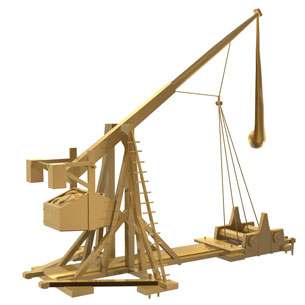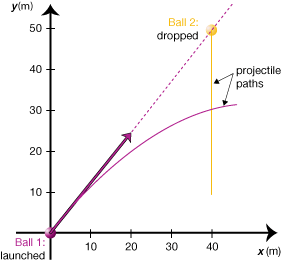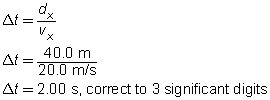Module 2—Motion in Two Dimensions
 Reflect and Connect
Reflect and Connect

© sgame/shutterstock
Today, the largest working trebuchet (of medieval design) can be found at Warwick Castle in central England. It is used as a tourist attraction and can be fired by members of the public under professional supervision. It stands 19 m tall and uses a 5443-kg counterweight to fire 15-kg stone balls nearly 100 m. More modern trebuchet designs can throw pianos weighing 225 kg over 250 m. In England, a group of farmers threw a car over 100 m and a 55-gallon drum filled with gasoline over 300 m. Research the medieval and modern design of today’s trebuchet.
 Reflect on the Big Picture
Reflect on the Big Picture
In this lesson you learned how to solve projectile-motion problems. You worked with the independent horizontal and vertical components of motion. You saw that Earth’s constant gravity gives important information when determining the path of a projectile. Can you imagine the joy the first scientist felt when this idea formed?
To help you reflect on your learning experience in this lesson, complete at least one of the following activities:
-
The ideas are fairly simple, but the calculations are not. Can you express the components of motion in a short paragraph that also shows how to solve a problem like TR 3?
-
Depict projectile motion in a painting, drawing, or sculpture. Add a short written explanation of how your artwork explains this lesson’s work. You can add your description to the course folder.
Store your completed reflection in your Physics 20 course folder.
 Going Beyond
Going Beyond
Principle of Projectile Motion
The projectile motion of an object subject to no air resistance is a combination of two motions—a horizontal motion with a constant velocity equal to the object's initial horizontal velocity and a vertical motion with a constant vertical acceleration (gravity).
The principle of projectile motion explains an interesting phenomenon that relates to the targeting of a falling object.
 Self-Check
Self-Check
SC 5. Where would you aim a projectile in order to hit a falling object? Try to find the answer "experimentally" with the Projectile Motion: Two Balls simulation by doing the following:
-
Set the air resistance to 0.000 kg/m. (Adjust air resistance with “Drag Coeff. Slider.”)
-
Press the “Data” button for the display of information for each balls.
-
Drag ball 1 to point (x, y) = (0.0, 0.0) m.
-
Drag ball 2 to any point to the right and well above ball 1.
-
Aim the initial velocity of ball 1 directly at ball 2.
-
Set the initial horizontal and vertical velocity of ball 2 to zero (similar to Figure 1).
-
Play the motions, and observe the path of the projectiles.
SC 6. Change the magnitude (not the direction) of the initial velocity for ball 1 to any value you choose. Press “Play,” and observe for a collision. Will the two balls always collide as long as the velocity of ball 1 is directed straight towards ball 2?
 Self-Check Answers
Self-Check Answers
SC 5. It is tempting to think that, with (g) at 9.81 m/s2, the velocity direction will not lead to a collision between the balls, because ball 2 will move away from the spot at which the velocity is aimed. However, you will find that with this initial velocity the balls will in fact collide. They will collide at the point in Figure 1 where the curved maroon path intersects the straight orange path.
SC 6. The initial velocity doesn’t matter. The balls always collide.
An explanation for the collision in the Self-Check questions is in the following equation: ![]()
This equation says that displacement is the sum of two terms, ![]() and
and ![]() . In words, this equation describes the principle of projectile motion.
. In words, this equation describes the principle of projectile motion.

Figure 1
The projections of projectile motion onto the horizontal and vertical axes are motions with constant horizontal velocity and constant vertical acceleration, respectively. The acceleration along the vertical axis is downward and, on Earth, has a magnitude of g = 9.81 m/s2.
- The horizontal displacement caused by constant horizontal velocity is defined by
 .
.
- The vertical displacement with constant vertical acceleration starting from rest is defined by

What does the principle of projectile motion imply when ball 1 has its initial velocity aimed at ball 2? The implication is illustrated in Figure 2. The dotted line shows what the path of the projectile would be if there were no gravitational effects. The blue curved path shows the actual path of the projectile. The path curves because gravity pulls the projectile down after it is released.

Figure 2
First, imagine that there is no vertical acceleration acting on either ball. If this were the case, then ball 1 would travel along a straight-line path with displacement defined by ![]() until it collided with ball 2, which remains at rest because there is no vertical acceleration acting on it either.
until it collided with ball 2, which remains at rest because there is no vertical acceleration acting on it either.
Now, imagine the same situation but with a vertical acceleration. During the time it takes ball 1 to reach the original starting position of ball 2, the vertical acceleration causes ball 1 to have a vertical displacement defined by ![]() . Simultaneously, the same acceleration acts on ball 2 during the same time interval to cause exactly the same vertical displacement.
. Simultaneously, the same acceleration acts on ball 2 during the same time interval to cause exactly the same vertical displacement.
Therefore, the two balls must collide at some point. The two simultaneous displacements of ball 1 are shown in red, and the downward displacement of ball 2 is shown in yellow on Figure 2. This completes the explanation.
Notice that the explanation did not depend on the initial speed of the projectile. Only the direction of the initial velocity was critical. The initial speed of the projectile only determines how much time elapses until the two balls collide—not whether they collide.
For example, suppose that the horizontal motion of the projectile was 20.0 m/s. Of the two motions contributing to the projectile motion of ball 1, only the horizontal motion with the constant velocity will move the ball towards the vertical fall line of ball 2. Since ball 1 has to move a horizontal distance of Δdx = 40.0 m to reach the vertical trajectory of ball 2, the time interval Δt required is

 Module 2: Lesson 3 Assignment
Module 2: Lesson 3 Assignment
Remember to submit the Module 2: Lesson 3 Assignment to your teacher.
Select an item from your Physics 20 course folder that you haven’t yet shared with your teacher, and share it.
Choose one of the four sports that you researched in Lesson 1 and Lesson 2. Do a more in-depth search for information on the requirements of the equipment used and about the standards that the equipment must meet. Continue to store your project work in your Physics 20 course folder. You will submit this research to your teacher at the end of Lesson 4 as part of your Module 2 Project.